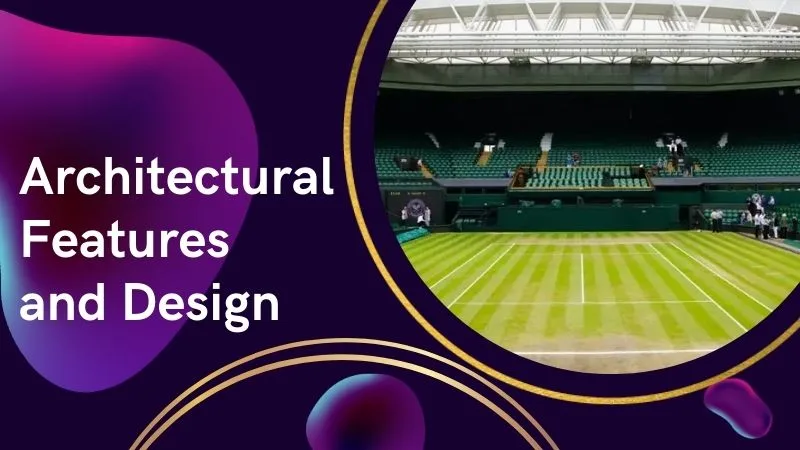Discover the magic of Wimbledon’s Center Court, where history, stunning architecture, and legendary matches create an unforgettable tennis experience.
Wimbledon’s Center Court: A Blend of Tradition, Architecture, and Legendary Matches
The prestigious Center Court Wimbledon embodies a seamless fusion of Wimbledon history, unique architectural design, revered Wimbledon traditions, and unforgettable Centre Court matches.
History and Significance of Wimbledon’s Center Court

The Wimbledon Championships, held at the iconic Center Court Wimbledon, are steeped in rich history and tradition. Since its inception, this famous tennis court has been the stage for countless legendary matches that have defined the sport’s legacy. Originally established as part of the All England Club, Center Court has evolved into a symbol of excellence and prestige in the tennis world. Its unique grass court surface offers players a challenging yet rewarding experience, contributing to its revered status. Over the decades, the Centre Court history has witnessed numerous memorable moments, underscoring its pivotal role in shaping Wimbledon heritage. This legendary venue continues to captivate audiences worldwide with its unmatched atmosphere and enduring significance.
Origins and Early Years
The origins of Center Court Wimbledon trace back to 1877, when the Wimbledon Championships began at the All England Club. Initially a modest event, it rapidly gained popularity, soon establishing itself as an essential part of Wimbledon history. The early years were marked by simple wooden stands and a limited seating capacity, yet the court’s charm captivated tennis enthusiasts. As the tournament grew, so did Center Court’s significance, becoming synonymous with high-quality tennis on its pristine grass court. Over the decades, this iconic tennis venue evolved both architecturally and culturally, setting the stage for future enhancements that would solidify its place in tennis legacy. These formative years laid the groundwork for traditional values still cherished today.
Development Over the Decades
Over the decades, Center Court Wimbledon has undergone significant transformations, reflecting both technological advancements and evolving spectator expectations. Initially, the famous tennis court featured basic wooden stands, but as the Wimbledon Championships gained global prominence, expansions were necessary to accommodate growing audiences. Enhancements in Wimbledon seating capacity ensured more fans could experience the electrifying Centre Court matches. The introduction of floodlights allowed play to extend into evening hours, increasing accessibility for global viewers. Each architectural evolution was meticulously planned to preserve the court’s historic charm while embracing modernity. These thoughtful upgrades over the years have cemented Center Court’s status as an iconic tennis venue, ensuring it remains a beloved site for both players and spectators alike.
Center Court’s Role in Wimbledon Heritage
Center Court Wimbledon stands as the heart of Wimbledon heritage, embodying the traditions and values that define the Wimbledon Championships. This iconic tennis venue has been integral to cultivating the prestigious atmosphere associated with the tournament. As the main stage for historic matches, Center Court has hosted legendary performances that have become part of tennis folklore. Its lush grass court is a testament to the tournament’s commitment to preserving classic tennis elements amidst modern changes. The court is not only a symbol of sporting excellence but also serves as a cultural touchstone, linking past generations with the present. Center Court’s enduring legacy continues to inspire new players and captivate audiences, perpetuating its revered status in Wimbledon history.
Architectural Features and Design of Center Court

The Wimbledon Centre Court design is a perfect blend of aesthetic elegance and functional prowess. From its inception, the court’s architecture has been meticulously crafted to enhance both player performance and spectator experience. The iconic Centre Court architecture showcases a harmonious balance between tradition and innovation, featuring its renowned grass court which demands a unique style of play. Over the years, enhancements have been made to preserve its historic charm while incorporating modern elements, such as improved seating arrangements and state-of-the-art facilities. The architectural evolution reflects the influence of the All England Club, ensuring it remains at the forefront of tennis venues worldwide. These thoughtfully integrated features make Center Court a captivating environment for both players and spectators.
Initial Architectural Design
The initial architectural design of Center Court Wimbledon was a masterful combination of simplicity and function. In the early years, the court featured basic wooden stands, reflecting the modest beginnings of the Wimbledon Championships. Despite its simplicity, this design offered an intimate viewing experience, with fans close to the action on the grass court. The uncomplicated layout facilitated easy access and emphasized the purity of the game, setting the stage for the iconic status it would achieve. The original architecture laid a solid foundation, allowing for future expansions and adaptations while preserving its core essence. This thoughtful initial design ensured that Center Court remained adaptable to changing needs without losing its historic charm and essential characteristics.
Evolution of Centre Court Architecture
The architectural evolution of Center Court Wimbledon is a testament to its ability to adapt while preserving tradition. Initially featuring simple wooden stands, the court has seen numerous enhancements over the decades to accommodate growing audiences and modern requirements. With each renovation, care was taken to integrate new technologies without compromising historic aesthetics. The introduction of permanent seating, improved sightlines, and advanced facilities marked significant milestones in its development. Architectural updates have also included aesthetic refinements, enhancing both functionality and spectator experience. This evolution reflects a commitment to maintaining the iconic status of Center Court as a premier venue within the tennis world. By balancing innovation with tradition, it continues to captivate fans and players alike, ensuring its enduring legacy.
Influence of All England Club on Design
The All England Club has played a pivotal role in shaping the design of Center Court Wimbledon, ensuring it embodies both tradition and modernity. This esteemed institution has consistently prioritized maintaining the court’s historical elegance while integrating necessary enhancements. The club’s vision has guided architectural decisions, balancing aesthetics with functionality to create a harmonious spectator experience. Their influence is evident in every architectural update, from seating arrangements that maximize visibility to advanced facilities catering to player needs. The club’s commitment to excellence ensures Center Court remains a symbol of tennis prestige. Through strategic planning and design foresight, the All England Club continues to uphold the court’s iconic status, seamlessly blending heritage with contemporary advancements for future generations.
The Role of Center Court in Wimbledon’s Traditions

Center Court Wimbledon is a cornerstone of Wimbledon traditions, serving as the epicenter for rituals and ceremonies that define the tournament’s unique identity. Its grass court is iconic, symbolizing the purity and heritage of tennis played at Wimbledon. The court hosts the opening ceremony and final matches, signifying its centrality to the tournament’s proceedings. Traditions such as the royal box, strawberries and cream, and the all-white dress code are deeply intertwined with the atmosphere of Centre Court, enriching the Centre Court experience for both players and spectators. These enduring customs contribute to the court’s mystique, making it not just a place of competition but also a cultural landmark that celebrates the sport’s rich legacy.
Center Court’s Grass Court Significance
The grass court at Center Court Wimbledon is not only a playing surface but a symbol of the tournament’s commitment to tradition. As one of the few grass courts remaining in professional tennis, it holds significant value in maintaining the heritage of the game as originally played. The meticulous upkeep of this lush green surface reflects the dedication of the All England Club to preserving the court’s historical essence. Its unique characteristics influence the style of play, requiring agility and precision, thus challenging even the most seasoned players. This significance extends beyond gameplay, as the pristine grass represents the elegance and timeless appeal of the Wimbledon Championships, resonating with audiences worldwide and solidifying its place in tennis history.
Traditions Unique to Center Court
Center Court Wimbledon is steeped in traditions that set it apart from other tennis venues. One of the most iconic customs is the presence of the royal box, where members of the British royal family and distinguished guests are often seen enjoying matches, adding a touch of elegance and prestige. The tradition of players wearing all-white attire is strictly upheld, symbolizing the purity and decorum associated with the Wimbledon Championships. Additionally, the consumption of strawberries and cream by spectators is a cherished ritual, enhancing the quintessentially British atmosphere. These unique traditions contribute significantly to the court’s charm and allure, making every visit to Center Court not just about witnessing world-class tennis but also partaking in a storied cultural experience.
Impact of Traditions on Center Court Experience
The traditions surrounding Center Court Wimbledon profoundly enhance the spectator experience, transforming it into more than just a sporting event. These customs create an atmosphere of elegance and respect that is felt throughout the tournament. The all-white dress code for players ensures a timeless aesthetic, reinforcing Wimbledon’s prestigious image. The presence of the royal box adds a sense of grandeur, reminding attendees of the event’s historical importance. Spectators also partake in traditions like enjoying strawberries and cream, making their visit uniquely British. This blend of customs cultivates a sense of continuity and nostalgia, enabling fans to connect with the rich tapestry of Wimbledon history. Ultimately, these traditions elevate each match, offering an unparalleled and immersive Centre Court experience.
Iconic Matches and Moments on Center Court

Center Court Wimbledon has been the stage for some of tennis’s most iconic matches, cementing its place in Wimbledon history. Legendary encounters between tennis greats have unfolded on this hallowed ground, creating unforgettable moments that resonate with fans worldwide. The court witnessed Björn Borg’s epic battles with John McEnroe, epitomizing intense rivalry and sportsmanship. More recently, Roger Federer and Rafael Nadal delivered a match for the ages in 2008, widely regarded as one of the greatest Wimbledon finals. These matches are not merely contests; they are narratives of endurance, skill, and drama that define the spirit of the sport. Such moments ensure Center Court remains an iconic tennis venue, where history continues to be written with every game played.
Memorable Wimbledon Finals
The Wimbledon finals held on Center Court have produced some of the most memorable moments in tennis history. These matches are often climactic showdowns between the sport’s elite, unfolding on the world’s most famous tennis court. Notable finals include the 1980 thriller between Björn Borg and John McEnroe, where Borg triumphed after a dramatic fifth set. Another unforgettable final was in 2008, when Rafael Nadal defeated Roger Federer in an epic match that spanned nearly five hours, showcasing extraordinary talent and determination. Such finals not only capture the imaginations of millions but also define the legacy of Centre Court Wimbledon, as they encapsulate the pinnacle of athletic achievement and emotional intensity characteristic of the Wimbledon Championships.
Tennis Legends at Wimbledon
Center Court Wimbledon has been graced by numerous tennis legends, each etching their mark in Wimbledon history. Icons such as Rod Laver, Martina Navratilova, and Pete Sampras have showcased their prowess on this revered stage, captivating audiences with their exceptional skill. The court has also witnessed Serena Williams and Steffi Graf dominate the grass surface, reflecting the evolution of women’s tennis. These legends not only highlight individual brilliance but also contribute to the storied legacy of the Wimbledon Championships. Their careers are intertwined with the essence of Center Court, where triumphs and rivalries unfold. For many players, achieving greatness at Wimbledon is synonymous with career-defining moments, solidifying their status as enduring figures in the sport’s rich narrative.
Center Court Events that Shaped History
Center Court Wimbledon has hosted pivotal events that have significantly shaped both the tournament and tennis history. From groundbreaking matches to memorable ceremonies, these events transcend mere sportsmanship, impacting broader cultural contexts. One such moment was the 1977 centenary celebration of the Wimbledon Championships, which highlighted the tournament’s enduring legacy. The 2010 epic match between John Isner and Nicolas Mahut also stands out, lasting over 11 hours and setting records for endurance and perseverance. Additionally, instances of rain delays and subsequent matches under the new retractable roof have demonstrated innovative adaptations to preserve the spirit of the game. These events not only enhance the allure of Centre Court but also contribute to its role as a bastion of tennis heritage and tradition.
Modern Innovations⁚ Retractable Roof and Seating Capacity

The integration of modern innovations, such as the Centre Court roof and enhanced Wimbledon seating capacity, has revolutionized the experience at Center Court Wimbledon. The retractable roof, implemented in 2009, ensures that matches can proceed uninterrupted by inclement weather, preserving the schedule and maintaining the quality of play on the grass court. This innovation allows for a seamless viewing experience, regardless of weather conditions, enhancing the overall Wimbledon atmosphere. Additionally, the increase in seating capacity to accommodate more spectators reflects a commitment to accessibility and inclusivity, allowing a greater number of tennis enthusiasts to witness live matches. These advancements reinforce Wimbledon’s heritage while adapting to contemporary needs, ensuring that Center Court remains an iconic venue for future generations.
Implementation of the Retractable Roof
The introduction of the Centre Court roof at Wimbledon marked a significant milestone in the tournament’s modernization efforts. Completed in 2009, this technological marvel was designed to address the persistent issue of rain delays, ensuring uninterrupted play during the prestigious Wimbledon Championships. The engineering feat involved installing a state-of-the-art retractable structure made of lightweight materials and supported by robust steel trusses. This design allows for rapid closure, transforming the open-air court into an indoor venue within minutes. The implementation not only preserves the integrity of the grass court but also maintains optimal conditions for both players and spectators. By embracing this innovation, Center Court seamlessly blends tradition with modernity, reinforcing its status as an iconic tennis venue.
Enhancements in Seating Capacity
The increase in Wimbledon seating capacity at Center Court reflects a strategic enhancement aimed at accommodating a growing number of tennis enthusiasts. This expansion allows more fans to experience the thrill of live matches, with the seating now comfortably hosting up to 15,000 spectators. This development not only underscores the popularity and global appeal of the Wimbledon Championships but also ensures that more people can witness historic moments firsthand. The careful design retains the intimate atmosphere that Center Court is renowned for while improving accessibility and comfort for attendees. By expanding its capacity, Centre Court Wimbledon balances tradition with modern requirements, ensuring it remains a premier destination for tennis lovers worldwide, enhancing both spectator engagement and the overall event experience.
Impact of Modern Innovations on Wimbledon Atmosphere
The introduction of modern innovations, such as the Centre Court roof and expanded seating, has significantly transformed the Wimbledon atmosphere. These advancements ensure that matches proceed without weather interruptions, offering a seamless experience for players and spectators; The retractable roof provides shelter while maintaining an open-air feel when retracted, preserving the traditional ambiance. Enhanced Wimbledon seating capacity allows more fans to partake in the iconic Centre Court experience, amplifying the energy and excitement during matches. These changes have modernized the venue without diminishing its storied heritage. By blending tradition with innovation, Center Court continues to captivate audiences globally, offering a perfect balance of historic charm and contemporary comfort, ensuring its status as a premier destination for tennis aficionados.
